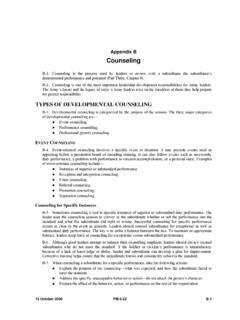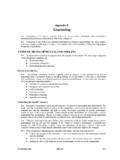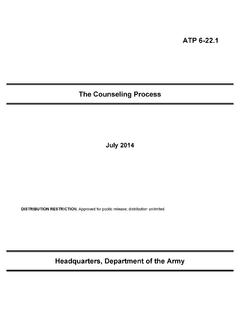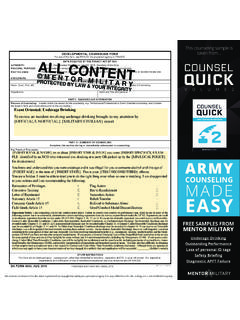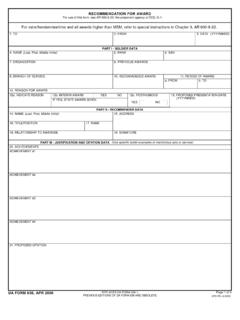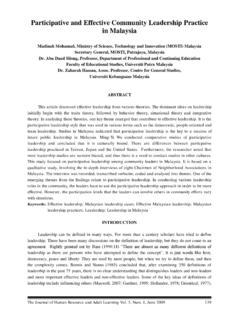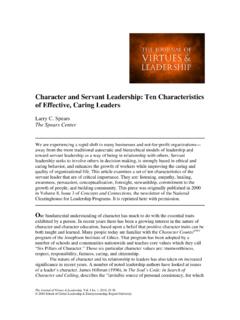Transcription of LEADERSHIP COUNSELING
1 SUBCOURSE EDITION QM3515 A LEADERSHIP COUNSELING LEADERSHIP COUNSELING Subcourse Number QM3515 EDITION A United States Army Combined Arms Support Command Fort Lee, VA 23801-1809 5 Credit Hours Edition Date: September 1993 SUBCOURSE OVERVIEW This subcourse is designed to teach you how to identify both the need for COUNSELING and the appropriate type of COUNSELING to use. These COUNSELING types include the following: o Reception and integration COUNSELING which identifies and resolves soldier's problems or concerns and conveys unit standards. o Performance COUNSELING . o Personal COUNSELING for domestic problems. o Indebtedness COUNSELING . o Drug and alcohol problems. o Disciplinary COUNSELING .
2 O Professional growth and guidance COUNSELING which addresses the development of subordinates. Also, you will learn how to identify and use the directive, nondirective and combined COUNSELING approaches. In addition, you will learn how to train subordinate leaders for COUNSELING using role modeling, feedback, and role-playing techniques. There are no prerequisites for this subcourse This subcourse reflects the doctrine which was current at the time it was prepared. In your own work situation, always refer to the latest official publications. Unless otherwise stated, the masculine gender of singular pronouns is used to refer to both men and women. i QM3515 TER MINAL LEARNING OBJECTIVE ACTION: You will identify the need for COUNSELING ; develop a COUNSELING program; identify the appropriate type of COUNSELING , which includes reception and integration COUNSELING that further identifies and resolves soldiers' problems or concerns and conveys unit standards.
3 You will learn about performance COUNSELING ; personal COUNSELING for domestic problems; indebtedness; drug and alcohol problems; disciplinary COUNSELING ; and professional growth and guidance COUNSELING which addresses the development of subordinates. Also, you will identify and use the appropriate COUNSELING approach which includes the directive approach , nondirective approach , and the combined approach . In addition, you will be able to train subordinate leaders for COUNSELING using role modeling, feedback, and role-playing techniques. CONDITION: You will have information in this subcourse that is derived from FM 22-100 and FM 22-101, and extracts from FM 22-101. STANDARD: To demonstrate competency of this task, you must achieve a minimum of 70 percent on the subcourse examination.
4 QM3515 ii TABLE OF CONTENTS Section Page Subcourse Overview .. i Lesson 1: Identify COUNSELING Approaches, Characteristics, Principles, and Techniques .. 1-1 Part A: Identify COUNSELING Approaches .. 1-1 Part B: Identify the Principles, Characteristics, and Techniques of COUNSELING .. 1-12 Practice Exercise .. 1-37 Answer Key and Feedback .. 1-40 Lesson 2: Identify the Types of COUNSELING .. 2-1 Part A: Conduct Reception and Integration COUNSELING .. 2-2 Part B: Conduct Performance COUNSELING .. 2-4 Part C: Conduct Personal COUNSELING .. 2-9 Part D: Conduct Disciplinary COUNSELING .. 2-11 Part E: Conduct Professional Growth and Guidance COUNSELING .
5 2-13 Practice Exercise .. 2-15 Answer Key and Feedback .. 2-17 Lesson 3: Prepare for and Conduct a COUNSELING Session and Refer Counselee to Outside Agencies .. 3-1 Part A: Prepare for the COUNSELING Session .. 3-2 Part B: Conduct a COUNSELING Session .. 3-9 iii QM3515 Part C: Refer a Counselee to Outside Agencies .. 3-16 Practice Exercise.. 3-23 Answer Key and Feedback .. 3-26 Lesson 4: Train Subordinate Leaders via Role Modeling, Feedback, and Role Playing .. 4-1 Practice Exercise .. 4-6 Answer Key and Feedback .. 4-8 Appendix A: List of Common Acronyms .. A-1 Appendix B: Publication Extracts .. B-1 FM 22-101, LEADERSHIP COUNSELING , June 1985 Use the above publication extracts to take this subcourse.
6 At the time we wrote this subcourse, this was the current publication. In your own work situation, always refer to the latest publications. QM3515 iv LESSON 1 IDENTIFY COUNSELING APPROACHES, CHARACTERISTICS, PRINCIPLES, AND TECHNIQUES Critical Tasks: 03- OVERVIEW LESSON DESCRIPTION: In this lesson, you will learn how to identify COUNSELING approaches, characteristics, principles, and techniques. TERMINAL LEARNING OBJECTIVE: ACTIONS: Identify COUNSELING approaches, characteristics, principles, and techniques. CONDITIONS: You will be given information in this lesson that is derived from FM 22-100 and FM 22-101. STANDARDS: Identifying COUNSELING approaches, characteristics, principles, and techniques will be in accordance with FM 22-100 and FM 22-101.
7 REFERENCES: The material contained in this lesson was derived from the following publications: FM 22-100 and FM 22-101. INTRODUCTION As a leader, you can expect to perform a variety of COUNSELING services using the directive COUNSELING approach , the nondirective COUNSELING approach , or a combination of both (the combined or eclectic approach ). By studying this lesson, you will learn about such COUNSELING approaches, about the characteristics, principles, and techniques of COUNSELING , and LEADERSHIP attributes. PART A - IDENTIFY COUNSELING APPROACHES 1. Purpose. Think about your career--from your initial entry into the military until now. During this period, how many times have you 1-1 QM3515 been effectively counseled by a superior?
8 How many times have you counseled a subordinate? Do these figures surprise you? Do you think that both figures should have been higher or lower? Perhaps the real problem is communication--that is, everyone has a different idea of what COUNSELING is. The following paragraphs define some COUNSELING terms. COUNSELING is the process of listening to the counselee and communicating advice, instruction, or judgment with the intent of influencing that person's attitude or behavior. It is a process which involves at least two people--the aim of one is to help the other use his personal resources to better cope with life. 2. COUNSELING Interview. COUNSELING is usually performed through the use of an interview. The purpose of a COUNSELING interview is to-- o find facts, o inform, and o alter opinions, feelings, and behavior.
9 The COUNSELING interview is a communication process in which you, the counselor, interview an individual to find out something from him, to tell him something, or to effect some change in him. Quite possibly, you may have more than one purpose for a given interview. However, usually only one purpose dominates. 3. Types. Keep in mind the purposes of COUNSELING and the COUNSELING interview. Look at the two different types of COUNSELING that you, as a leader, employ. a. Performance COUNSELING . Performance COUNSELING helps to improve the performance of an individual or group or helps to maintain a level of performance that already exists. Performance COUNSELING is discussed in detail in Lesson 2. b. Personal COUNSELING . Personal COUNSELING helps the individual arrive at a solution to his problems.
10 Personal problems range from grievances pertaining to rank, promotion, job assignments, and discrimination by others to financial difficulties, family troubles, or other factors that involve the individual's well-being. Personal COUNSELING is discussed in detail in Lesson 2. Personal COUNSELING and performance COUNSELING do not exclude each other. Helping a soldier solve a problem in a personal COUNSELING situation may well solve a problem that surfaced during performance COUNSELING . QM3515 1-2 4. Approaches To COUNSELING . There are as many approaches to COUNSELING as there are counselors. Effective leaders approach each soldier as an individual and probably never use exactly the same approach with other soldiers. The approaches used in military COUNSELING are-- o Directive.



